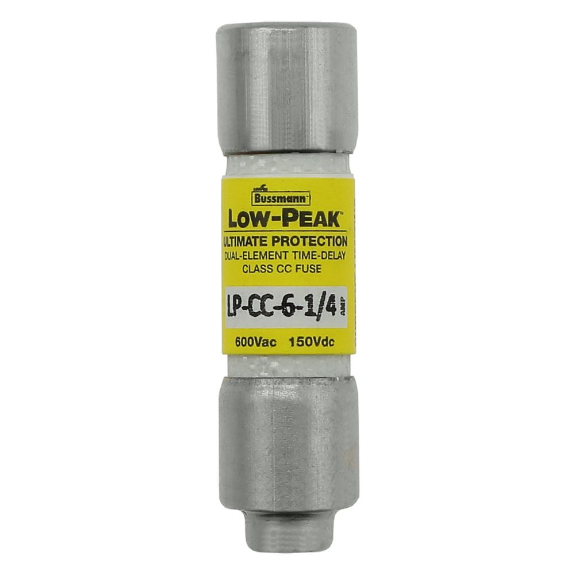Bussmann LP-CC-6-1/4 fuse prevents spontaneous tripping during motor and equipment startup phases. This slow-blow fuse is paired with an indicating fuse block to protect an electrical circuit when subjected to heavy loads and short circuits in commercial and industrial applications.
Working Mechanism:
- When faced with overcurrent, the flow of current through the fuse elements surpasses their designated capacities, inducing heat in both elements.
- The high-current element promptly reacts to short-circuit scenarios. As excessive current generates escalating heat, this element rapidly melts, inducing an arc that halts the circuit.
- The time-delay element addresses momentary overcurrents from inrush currents or motor starting. It heats up due to elevated current levels but boasts a controlled melting point, enabling it to withstand transient overcurrents.
- As the short-circuit element melts, it rapidly terminates the circuit and isolates the faulty portion. Simultaneously, the time-delay element remains unaffected, preventing unwarranted tripping due to transient overcurrents.
Features:
- It features a cylindrical body, ensuring a seamless and secure installation.
- This time delay relay fuse is made of melamine for electrical insulation and mechanical strength.
- It features a dual-element design enhancing protection and reliability in medium voltage circuits.
- This time delay relay fuse incorporates a time delay speed for controlled response in specific operational scenarios.
- It has an interrupt rating of 200kA at 600VAC and 20kA at 150VDC, allowing robust circuit protection against high current incidents.
Compatible Accessories:
- Bussmann HEB-AA Fuse Holder: This in-line fuse holder is designed to work seamlessly with Class CC fuses having ratings up to 30A. It is ideal to hold fuses to prevent hazards due to overcurrents.
- Bussmann CHCC3DU Fuse Block: This finger-safe fuse block can be used with Class CC fuses, offering overcurrent protection.
- Bussmann HPF-RR Fuse Holder: This fuse holder offer panel-mounting & safeguards fuses to prevent overcurrent hazards.
Frequently Asked Questions:
Q. How do I maintain this Bussmann LP-CC-6-1/4 fuse?
A.
- Periodically examine the fuse holder, fuse contacts and fuse itself for indications of damage, corrosion or overheating. Swiftly replace any impaired components.
- Ensure that the fuse is accurately sized. Selecting a fuse that is too small can trigger premature failures, while an oversized fuse may fail to offer adequate protection.
- Maintain the cleanliness of the fuse holder contacts, ensuring they remain free of dirt, debris and oxidation.
- Safeguard spare fuses by storing them in a clean and dry environment.
Q. How can I determine if a fuse is operational?
A. Place one of the multimeter probes at one end of the fuse and position the second probe at the opposite end. If the reading on the display falls within the range of 0 to 5 ohms, it signifies that the fuse is in proper working condition without any damage.
Q. Is it possible to test a live fuse?
A. Place the meter leads on opposite ends of the fuse. If the displayed voltage is negligible or absent, it indicates the fuse is functioning correctly. However, if a voltage difference is evident (typically matching the total supply voltage), this points to a faulty fuse.
Q. How can I select an appropriate fuse for my application?
A.
- Consider the regular operational current.
- Account for the voltage during operation.
- Factor in the ambient temperature conditions.
- Address initial inrush currents.
- Consider the peak fault current.
- Evaluate the required duration for the fuse to open.
 Change Country
Change Country

 In Stock : 111 Units
In Stock : 111 Units

